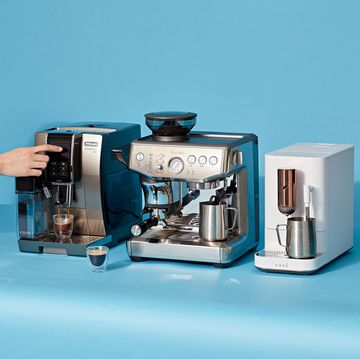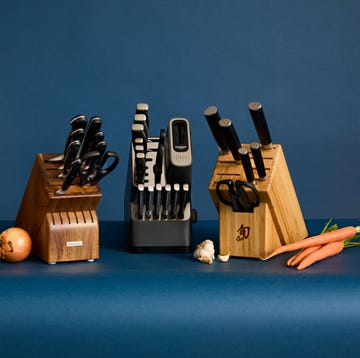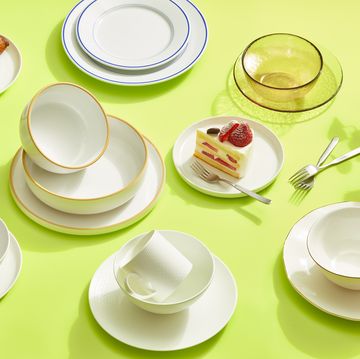Jump to:
- Pros and Cons of the Lodge Cast Iron Skillet
- What we love about Lodge
- How we test cast iron skillets
- My experience with the Lodge cast iron skillet
- How do I clean a cast iron skillet?
- How does Lodge compare to other cast iron brands?
- The bottom line: Is Lodge cast iron worth it?
- Why trust Good Housekeeping?
After 15 years in the food industry, I recently bought my first cast iron skillet — hard to believe, I know. I'm Tina Martinez, a food producer and product tester at the Good Housekeeping Institute and Test Kitchen. Over the years, I've tested various products from immersion blenders to electric griddles to kitchen torches. Our team of culinary and product experts has decades of experience with cast iron, from reviewing the best cast iron skillets to exploring recipes to cook in cast iron.
Before buying my first cast iron skillet, I worried about its ease of use. However, after cooking with cast iron several times in my professional life, I realized those concerns were unfounded. After using and testing the $20 Lodge 10.25-in. Cast Iron Skillet, I found that it offered the perfect space-saving solution in my small Brooklyn apartment with limited storage — it’s versatile enough to handle a wide variety of cooking tasks in one compact pan.
To see if the time-honored skillet actually delivered on performance, I worked with experts in the Good Housekeeping Institute Kitchen Appliances and Innovation Lab to evaluate how evenly the pan heated up, how well it maintained its temperature and how easy it was to handle and wash.
Pros and Cons of the Lodge Cast Iron Skillet
Lodge cast iron skillets have become a kitchen staple, known for their affordable prices and reliable quality. These pans feature high, straight sides, providing ample space for cooking and a generous surface area for searing. They’re designed with a short teardrop handle for balance and stability, along with a helper handle to make transferring from stove to oven easier. The 10.25-inch skillet is an ideal size for most standard stovetops and works seamlessly on gas, electric or induction ranges as well as in the oven or over a campfire. A cast iron skillet is built to handle the heat, no matter where you cook.
Here are the main benefits and downsides to using the Lodge cast iron skillet, at a glance:
Pros
- It's preseasoned, so it requires little oil or butter to grease the pan
- Does not require seasoning after each use
- Retains heat evenly
- Offers a lot of space and height for cooking
- Easy to clean and maintain
- Affordable and economical
Cons
- The overall weight of the skillet may be difficult for some to maneuver easily
- Like many other cookware materials, it can develop hot or cold spots when not positioned over the heat source evenly
- Can rust if not cared for properly
What we love about Lodge
At the Good Housekeeping Test Kitchen, we cook with cast iron every day and Lodge is one of our favorite brands. A fifth-generation family-owned business that has been around for over a century, Lodge is synonymous with quality, construction and versatility. It's affordable and great for beginners, home cooks and professional chefs alike. According to the brand, its cookware and accessories are free of PFAS. This is beneficial if you're looking for a nonstick pan that doesn't contain chemical additives, which may impact your health over time, per the CDC (though research is limited and ongoing).
In 2002, Lodge was the first company to create the “preseasoned” cast iron skillet. Unseasoned cast iron skillets must be treated by heating oil in the pan before your first use. This helps create a nonstick surface. Since this Lodge skillet is preseasoned, it's ready to use straight out of the box, though you need to maintain the seasoning over time. Seasoning helps maintain a nonstick surface and create a pan that's easy to clean.
Through personal and professional experience, I have cooked endless items in various Lodge cast iron skillets. I’ve relied on them for everything from a beautifully seared pork chop for a food styling shoot to a crispy pan pizza for dinner on a Friday night. It’s the brand I would recommend to young cooks (hello, cheap!) and beginners alike.
How we test cast iron skillets
I worked with the Kitchen Appliances and Innovation Lab to test this cast iron skillet according to their nonstick cookware standards. First, we inspect the overall appearance of the product and review any instructions that come with it. The Lodge 10.25-inch Cast Iron Skillet doesn’t come with a booklet but they attach a small flyer on the skillet itself with instructions to obtain the product manual online.
Next, we evaluate how evenly each pan heats, how well it maintains its heat, the effectiveness of the nonstick coating and how easy it is to handle and wash. We also consider features specific to the pan including weight and easy-to-hold handles.
My first test included cooking eggs without any butter or oil. We do this to assess the nonstick coating. Flipping a fried egg required a little force, but the egg eventually released without any tears or damage.
I seared a steak to see how well the skillet maintained heat. I cooked the steak to medium-rare and the pan created a perfectly brown and golden crust with a pink interior.
My experience with the Lodge cast iron skillet
During testing, I used this skillet frequently in the Test Kitchen and in my home kitchen, where I cooked everything from breakfast to dinner. The pan helped create a beautiful, caramelized frittata and a crisp crust on a pizza. Because it's oven-safe, I was able to make a whole chicken and the cheesiest enchiladas. It was also big enough for a one-pan chicken, rice and veggie dish. It created a great sear on pork tenderloin, chicken and salmon, all of which I started cooking in the pan on the stovetop, and then transferred to the oven to finish cooking.
How do I clean a cast iron skillet?
Despite popular belief, cast iron is fairly easy to clean. There are several accessories you can purchase to care for your cast iron skillet such as scrub cloths, a chainmail scrubbing pad or an entire care kit. But at the end of your cooking session, a little soap and water is all you really need. And yes, soap is a-OK on cast iron, just be sure to use it sparingly to avoid ruining the pan's nonstick coating.
After washing, dry your pan well so it doesn’t rust or leave marks. To dry your pan thoroughly, heat it on your stovetop over low until dry, remove it from the heat and coat the pan in a thin layer of neutral oil before storing away. With proper treatment and care these pans are built to last a lifetime.
How does Lodge compare to other cast iron brands?
I wasn't the only cook who preferred the Lodge 10.25-inch Cast Iron Skillet; it reigned supreme in the Good Housekeeping Institute Kitchen Appliances and Innovation Lab's review of the best cast iron skillets, winning best overall. The Lab has been testing cookware for decades and considers Lodge one of the best because of its value, durability and overall design.
The Lodge 10.25-inch skillet performed the best in our rigorous testing, scoring top marks in several cooking categories. We also liked the Utopia Kitchen Cast Iron Skillet, which offers great value for the 12-inch pan, and the Le Creuset Enameled Cast Iron Skillet, which is easy to clean and comes in a variety of colors.
The bottom line: Is Lodge cast iron worth it?
If you're looking for a quality, versatile pan that can handle a variety of tasks, the Lodge 10.25-inch Cast Iron Skillet is worth the $20 price tag.
Although it's heavy and requires hand-washing and occasional upkeep, it'll last for years (probably even decades). The pan functions on the stovetop, in the oven or over a campfire and it has nonstick capabilities but can retain high temps for charring and searing. It's a pan everyone should consider adding to their kitchens.
Why trust Good Housekeeping?
Tina Martinez is the food producer in the Good Housekeeping Test Kitchen. She has over 10 years of culinary experience, including recipe development and food styling for print, digital and television platforms. She cooks with cast iron at home and conducted the most recent round of testing for the Lodge 10.25-inch Cast Iron Skillet as part of this review.
Tina (she/her) is the food producer of the Hearst Lifestyle Group. She comes to Hearst with 10 years experience in the world of food styling for editorial, digital and television platforms. When she’s not cooking in her tiny Brooklyn kitchen, she can be found enjoying a beer at a local brewery, hiking in a national park or enjoying an afternoon at the beach.
Nicole (she/her) is the director of the Good Housekeeping Institute's Kitchen Appliances and Innovation Lab, where she has overseen content and testing related to kitchen and cooking appliances, tools and gear since 2019. She’s an experienced product tester and recipe creator, trained in classic culinary arts and culinary nutrition. She has worked in test kitchens for small kitchen appliance brands and national magazines, including Family Circle and Ladies’ Home Journal.
















